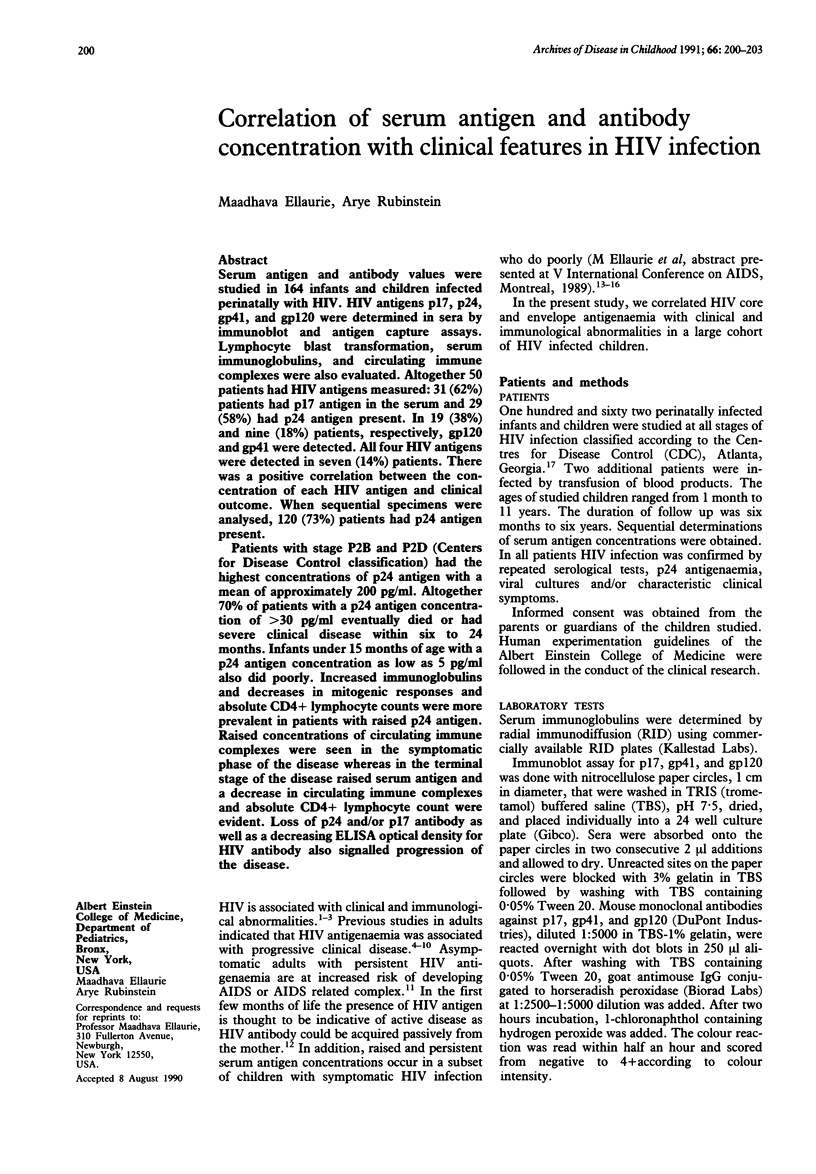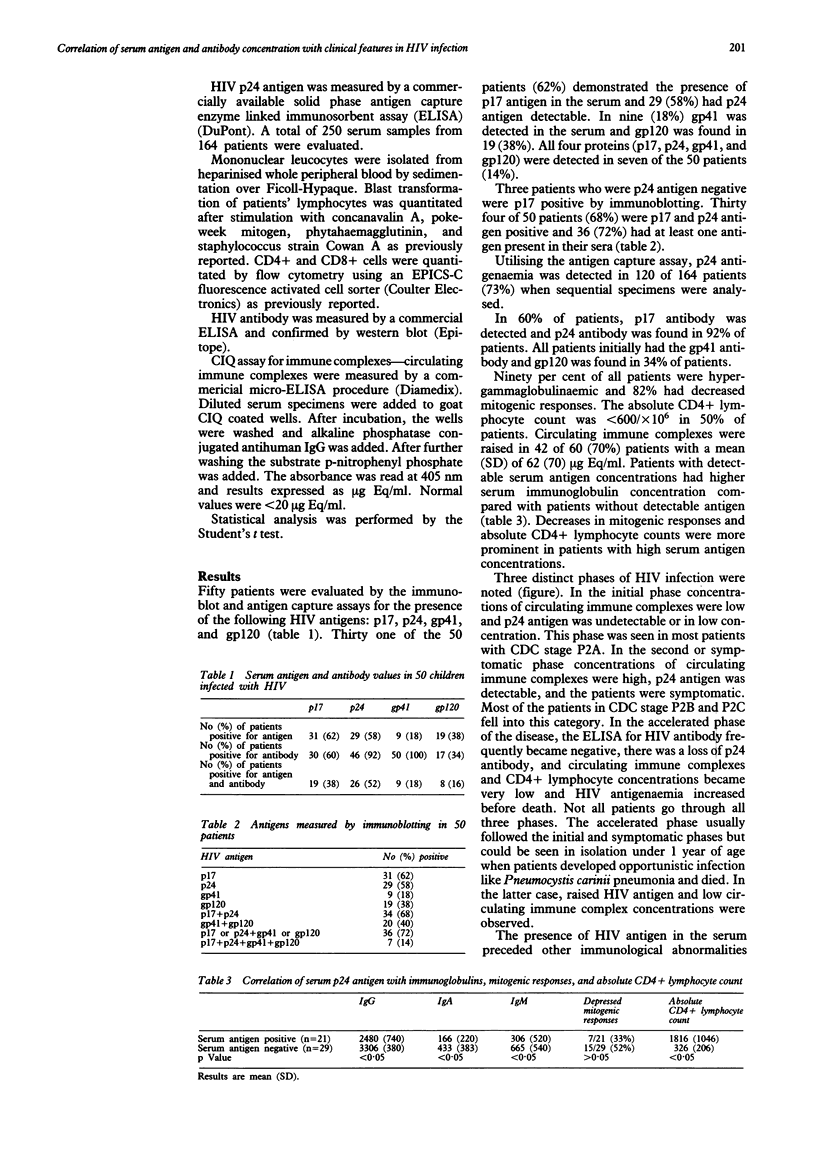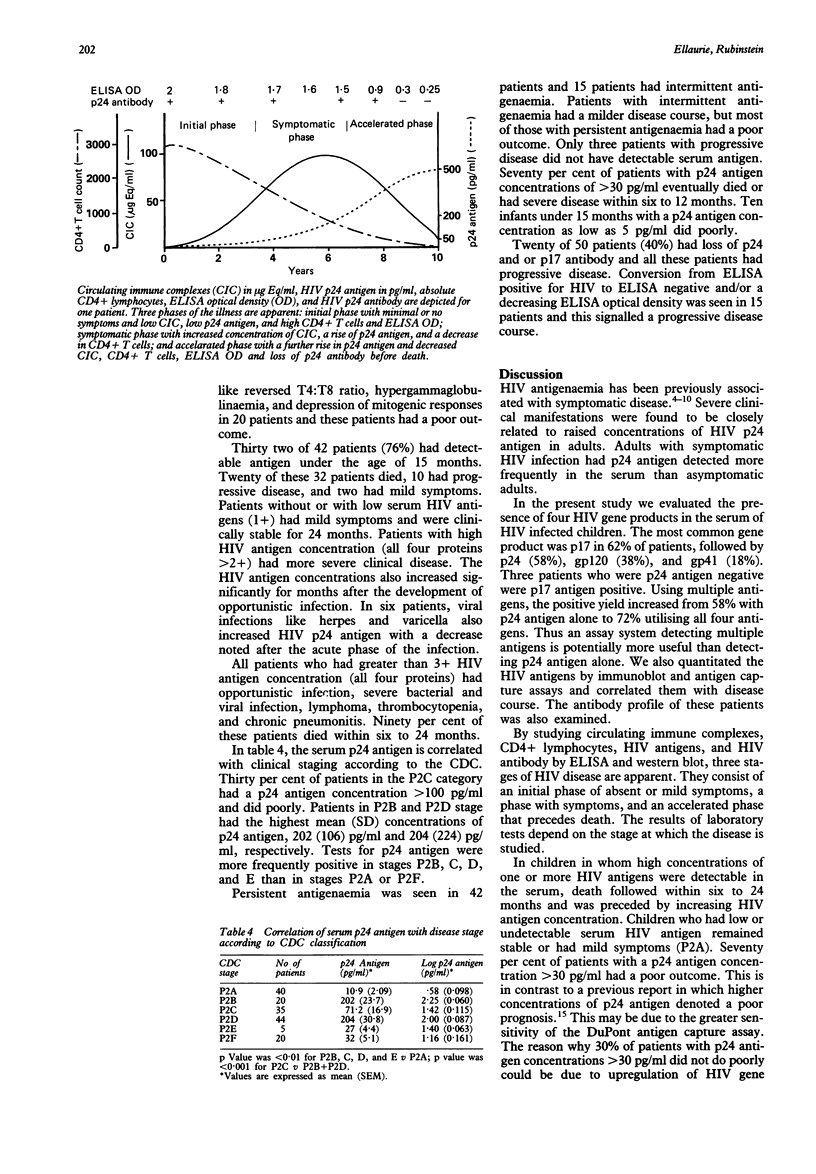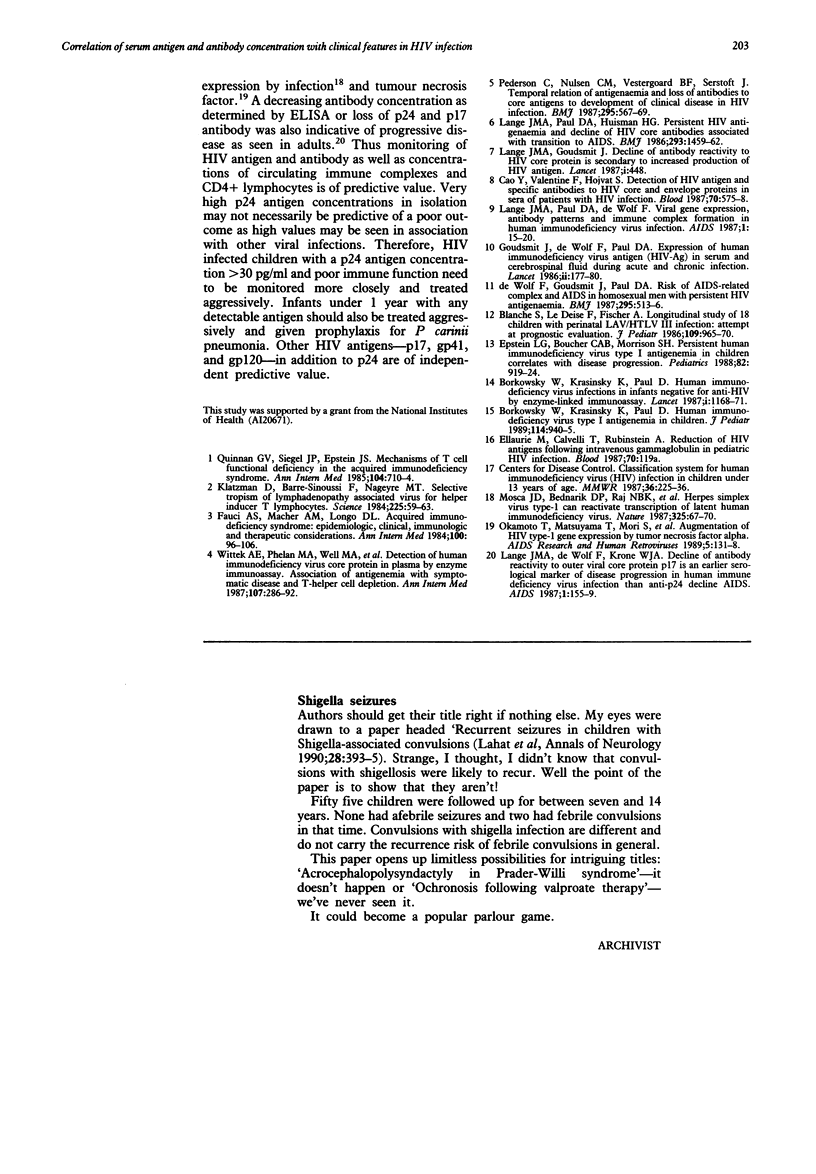Abstract
Serum antigen and antibody values were studied in 164 infants and children infected perinatally with HIV. HIV antigens p17, p24, gp41, and gp120 were determined in sera by immunoblot and antigen capture assays. Lymphocyte blast transformation, serum immunoglobulins, and circulating immune complexes were also evaluated. Altogether 50 patients had HIV antigens measured: 31 (62%) patients had p17 antigen in the serum and 29 (58%) had p24 antigen present. In 19 (38%) and nine (18%) patients, respectively, gp120 and gp41 were detected. All four HIV antigens were detected in seven (14%) patients. There was a positive correlation between the concentration of each HIV sequential specimens were outcome. When sequential specimens were analysed, 120 (73%) patients had p24 antigen present. Patients with stage P2B and P2D (Centers for Disease Control classification) had the highest concentrations of p24 antigen with a mean of approximately 200 pg/ml. Altogether 70% of patients with a p24 antigen concentration of greater than 30 pg/ml eventually died or had severe clinical disease within six to 24 months. Infants under 15 months of age with a p24 antigen concentration as low as 5 pg/ml also did poorly. Increased immunoglobulins and decreases in mitogenic responses and absolute CD4+ lymphocyte counts were more prevalent in patients with raised p24 antigen. Raised concentrations of circulating immune complexes were seen in the symptomatic phase of the disease whereas in the terminal stage of the disease raised serum antigen and a decrease in circulating immune complexes and absolute CD4+ lymphocyte count were evident. Loss of p24 and/or p17 antibody as well as a decreasing ELISA optical density for HIV antibody also signalled progression of the disease.
Full text
PDF



Selected References
These references are in PubMed. This may not be the complete list of references from this article.
- Blanche S., Le Deist F., Fischer A., Veber F., Debre M., Chamaret S., Montagnier L., Griscelli C. Longitudinal study of 18 children with perinatal LAV/HTLV III infection: attempt at prognostic evaluation. J Pediatr. 1986 Dec;109(6):965–970. doi: 10.1016/s0022-3476(86)80277-3. [DOI] [PubMed] [Google Scholar]
- Borkowsky W., Krasinski K., Paul D., Holzman R., Moore T., Bebenroth D., Lawrence R., Chandwani S. Human immunodeficiency virus type 1 antigenemia in children. J Pediatr. 1989 Jun;114(6):940–945. doi: 10.1016/s0022-3476(89)80434-2. [DOI] [PubMed] [Google Scholar]
- Cao Y. Z., Valentine F., Hojvat S., Allain J. P., Rubinstein P., Mirabile M., Czelusniak S., Leuther M., Baker L., Friedman-Kien A. E. Detection of HIV antigen and specific antibodies to HIV core and envelope proteins in sera of patients with HIV infection. Blood. 1987 Aug;70(2):575–578. [PubMed] [Google Scholar]
- Epstein L. G., Boucher C. A., Morrison S. H., Connor E. M., Oleske J. M., Lange J. M., van der Noordaa J., Bakker M., Dekker J., Scherpbier H. Persistent human immunodeficiency virus type 1 antigenemia in children correlates with disease progression. Pediatrics. 1988 Dec;82(6):919–924. [PubMed] [Google Scholar]
- Fauci A. S., Macher A. M., Longo D. L., Lane H. C., Rook A. H., Masur H., Gelmann E. P. NIH conference. Acquired immunodeficiency syndrome: epidemiologic, clinical, immunologic, and therapeutic considerations. Ann Intern Med. 1984 Jan;100(1):92–106. doi: 10.7326/0003-4819-100-1-92. [DOI] [PubMed] [Google Scholar]
- Goudsmit J., de Wolf F., Paul D. A., Epstein L. G., Lange J. M., Krone W. J., Speelman H., Wolters E. C., Van der Noordaa J., Oleske J. M. Expression of human immunodeficiency virus antigen (HIV-Ag) in serum and cerebrospinal fluid during acute and chronic infection. Lancet. 1986 Jul 26;2(8500):177–180. doi: 10.1016/s0140-6736(86)92485-2. [DOI] [PubMed] [Google Scholar]
- Hayward R. A., Shapiro M. F., Oye R. K. Laboratory testing on cerebrospinal fluid. A reappraisal. Lancet. 1987 Jan 3;1(8523):1–4. doi: 10.1016/s0140-6736(87)90698-2. [DOI] [PubMed] [Google Scholar]
- Klatzmann D., Barré-Sinoussi F., Nugeyre M. T., Danquet C., Vilmer E., Griscelli C., Brun-Veziret F., Rouzioux C., Gluckman J. C., Chermann J. C. Selective tropism of lymphadenopathy associated virus (LAV) for helper-inducer T lymphocytes. Science. 1984 Jul 6;225(4657):59–63. doi: 10.1126/science.6328660. [DOI] [PubMed] [Google Scholar]
- Lange J. M., Paul D. A., Huisman H. G., de Wolf F., van den Berg H., Coutinho R. A., Danner S. A., van der Noordaa J., Goudsmit J. Persistent HIV antigenaemia and decline of HIV core antibodies associated with transition to AIDS. Br Med J (Clin Res Ed) 1986 Dec 6;293(6560):1459–1462. doi: 10.1136/bmj.293.6560.1459. [DOI] [PMC free article] [PubMed] [Google Scholar]
- Lange J. M., Paul D. A., de Wolf F., Coutinho R. A., Goudsmit J. Viral gene expression, antibody production and immune complex formation in human immunodeficiency virus infection. AIDS. 1987 May;1(1):15–20. [PubMed] [Google Scholar]
- Lange J. M., de Wolf F., Krone W. J., Danner S. A., Coutinho R. A., Goudsmit J. Decline of antibody reactivity to outer viral core protein p17 is an earlier serological marker of disease progression in human immunodeficiency virus infection than anti-p24 decline. AIDS. 1987 Sep;1(3):155–159. [PubMed] [Google Scholar]
- Lange J., Goudsmit J. Decline of antibody reactivity to HIV core protein secondary to increased production of HIV antigen. Lancet. 1987 Feb 21;1(8530):448–448. doi: 10.1016/s0140-6736(87)90148-6. [DOI] [PubMed] [Google Scholar]
- Mosca J. D., Bednarik D. P., Raj N. B., Rosen C. A., Sodroski J. G., Haseltine W. A., Pitha P. M. Herpes simplex virus type-1 can reactivate transcription of latent human immunodeficiency virus. Nature. 1987 Jan 1;325(6099):67–70. doi: 10.1038/325067a0. [DOI] [PubMed] [Google Scholar]
- Okamoto T., Matsuyama T., Mori S., Hamamoto Y., Kobayashi N., Yamamoto N., Josephs S. F., Wong-Staal F., Shimotohno K. Augmentation of human immunodeficiency virus type 1 gene expression by tumor necrosis factor alpha. AIDS Res Hum Retroviruses. 1989 Apr;5(2):131–138. doi: 10.1089/aid.1989.5.131. [DOI] [PubMed] [Google Scholar]
- Pedersen C., Nielsen C. M., Vestergaard B. F., Gerstoft J., Krogsgaard K., Nielsen J. O. Temporal relation of antigenaemia and loss of antibodies to core antigens to development of clinical disease in HIV infection. Br Med J (Clin Res Ed) 1987 Sep 5;295(6598):567–569. doi: 10.1136/bmj.295.6598.567. [DOI] [PMC free article] [PubMed] [Google Scholar]
- Riley A. J., Bromwich P. Old and new causes of superficial dyspareunia. Br Med J (Clin Res Ed) 1987 Aug 29;295(6597):513–514. doi: 10.1136/bmj.295.6597.513. [DOI] [PMC free article] [PubMed] [Google Scholar]
- Wittek A. E., Phelan M. A., Wells M. A., Vujcic L. K., Epstein J. S., Lane H. C., Quinnan G. V., Jr Detection of human immunodeficiency virus core protein in plasma by enzyme immunoassay. Association of antigenemia with symptomatic disease and T-helper cell depletion. Ann Intern Med. 1987 Sep;107(3):286–292. doi: 10.7326/0003-4819-107-2-286. [DOI] [PubMed] [Google Scholar]


